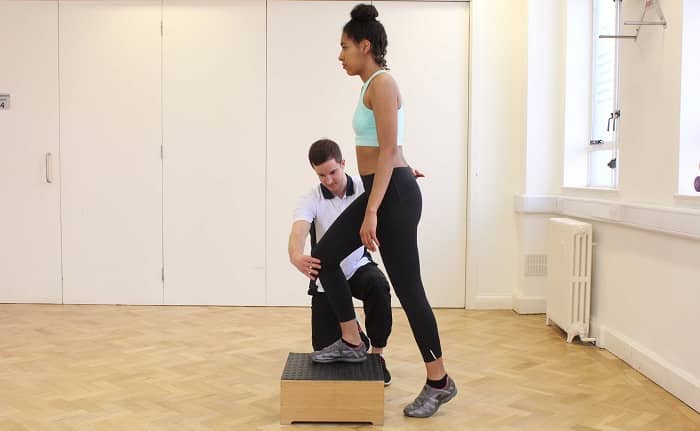Exercising is one of the best and perfect solutions to stay away from all sorts of issues. A meniscus tear is one of the common knee injuries that affect the people who are sure to play the contact sports.
So, we are sharing information about The Best exercise for a meniscus tear. It can also be caused by wear and tear.
One is doing the daily activities that put the pressure on the joint of the knee like the squatting exercises. It helps in picking something that gets in and out of the car.
Meniscus tear is not always painful
The meniscus tear is something that occurs when the person tears off the protective cartilage in the knee. A meniscus tear is not always painful.
It can swell and then create the instable create the right pressure on the knee. The knee may also lock, ad create more and more pressure. It drags down the trouble moving it.
Doctors determines the treatments
The nature of the injury indicates the right symptoms of the person helping in the doctor determining the treatments for the meniscus tear. The doctor truly determines the treatments for the meniscus tear and helps in to get well soon.
Young people, traumatic injury and other kind of injuries are highly appreciating in the right format. It requires the right surgery than any other older people.
Schedules of Exercise for Meniscus Tear
People with chronic meniscus injury are treated with better treatment schedule. Doctors often recommend taking up the right kind of exercises in the physical therapy exercises so that it helps in stabilizing the joint.
8 Best Exercise for a Meniscus Tear
There are varied types of exercises to try out the doctor’s approval with the right beginning of the exercising.

#1. Quadriceps setting
It is an isometric exercises to strengthen the front muscles on the thigh needs care while you exercise.
Sit on the ground with the legs extending the muscles with preferred focusing on the tightening on the back of the knee against the floor. Repeating the activity 10 times and resting for 30 seconds to 1 minute repeating the steps as according to steps involved.
The quadriceps setting of exercise helps in maintaining the exercises and allow in better sketch of a healthy life.
#2. Mini-squatting
Mini squatting is a differenttype of exercise that strengthens the quadriceps. Standing with the back against the wall allows the shoulders and the head strengthens the muscles.
Bending the knees slightly can bring in better feeling of the muscles in the thighs working with ease. Stop at the 15 degrees of the bending feels the muscles in the thighs with the best activity of the working.
It is not that you always have to do the exercise against the wall premises; you can strengthen the muscles by repeating the steps adding to its greater stability. The sturdy piece of the furniture is highly effective for the balance.
#3. Straight leg raise
The exercise of the straight leg raise can maintain the exercise in the best and possible ways. One needs to lie on the floor can leave behind the left foot flat on the floor.
The right leg extends the rough sketch of 45 degrees when the right knee is the same height as the left knee. Lowering the right leg allow in 25 total repetitions of the exercises.
Repeating the exercises can allow in good stretching of the muscles. Repeating the exercise on the left leg is the right one.
#4. Hamstring heel digs
Exercises work to strength the hamstrings of the legs challenging the muscles on the abdominal. Lying on the back with the knees is sure to bend the muscles rightly.
The feet are flat on the floor and you can exercise by flexing on the heels touching on the ground. Bringing the heels back towards the body can work slowly on the slide about 4 to 6 inches away from the body.
Repeating the exercises allow to get the right 8 to 10 times. Take rest for 30 seconds to that of the 1 minute. Users can easily take additional sets to run the best exercises.
#5. Leg extensions
The exercises are sure to create the right kind of the straightening of the right leg. Repeating the exercise for about 10-20 times allow the left leg to try out the performance of the exercises in the pointed foot.
Slowly the lowering of the leg while doing the leg extension exercises can bring in better exercises and strengthen the legs from within.
Experts opine to repeat the exercises quite deeply to maintain the strength rightly. The exercising of the legs and bring in better activity.
#6. Standing heel raises
The exercises strengthen the gastrocnemius and soleus muscles together make up the calf muscles. Standing the feet hip-width distance apart with the hands resting light on the chair and counter for support.
Slowly lift the heels up off the floor raising the balls of the feet. Pause the top with the slowly lower the heels backing down to the ground. Do 2 to 3 sets with 8 to 10 reps per set.
Tighten the gluteus buttocks muscles for balance. Keep the ankles in a neutral locus to preventing them from rolling towards the outer edges of the feet.
#7. Clams
The exercises target the hip abductors helping in to strengthen the minimums muscles. Lying on the uninjured side allows the stacking of the top of another and knees bent with 45 degrees angle.
Resting your head on the lower arm uses the right top arm with the stabilization of the position. Keeping the feet stacked on the top of another at all times slowly raises the muscles to a great extent with ease.
Wrap the resistance band around the thighs before beginning the exercises.
#8. Hamstring curls
With the proper execution of the hamstring curls and the exercises of the muscles allows the back of the thighs to start creating the slowly bending the knee as much as the process.
Do it 2 to 3 sets with 8 to 10 reps per set. Slowly lowering the foot back down the floor can avoid the pain to continue. It depends on the person to stay connected to the bending of the knees.
Stop exercising and you can easily bring in better activities. Remember never to exercise when the pain continues.
Exercises to avoid for meniscus tear
Doctors often advise against the performance of the performing certain exercises when someone is experiencing the right kind of meniscus tear. One can avoid exercises involves the following:
- pivoting
- deep squatting
- twisting
The exercises are sure to put in much to cease the pressure on already the unstable knee. If any exercise causes you pain or make your knee feel unstable, stop doing it right away.
What are the different types of tears?
Inside the knee, there is perfect kind of protective cartilages. It includes the articular and the meniscal cartilage that the cushion lets you the display of the joints providing the right kind of the stability.
The cartilage of the articular provides with the smooth and the right movement of the joint. The meniscal cartilage improves the perfect loading of the bearing and the abilities to offer with the right knee movement.
Doctors are usually the division of the meniscal tears into two different kinds of categories: acute traumatic tears and degenerative tears.
#1. Acute trauma
Acute traumatic tear most commonly occurs in young athletes. You may hear a popping sound upon injuring your knee. Other kind of symptoms of the acute traumatic tear includes:
- catching and locking of the joint
- joint pain and movement
- swelling and acute pain
#2. Degenerative tear
The degenerative tear causes repeated type of stress that weakens the cartilage from within.
The meniscus tear occurs over with the time and are most commonly seen in the people especially the middle-aged people.
The symptoms of the chronic meniscal tear seem similar to those of the acute tear.
Differing in the process of treatment
It is highly important to know that the differences between the tears offer with acute type of the traumatic tears are surgically repairable. Less than the 10 percent of the meniscal tears in the patients age offer 40 or older than can be repaired.
It is often because the tissue degeneration affects the blood flow to the cartilage, making the healing less likely after the surgery. A doctor may recommend by removing the damaged tissues suggesting the right kind of physical therapy exercises.
Exercises on the physical therapy exercises never necessarily heal the meniscus. They can prevent the stiffness. The exercises help in strengthening the muscles from within all around the knees by stabilizing the knee joints.
After the injury comes up stiff
Doctors never usually recommend the starting of the physical therapy. The meniscal tear can come up all along with the swelling and also the inflammation that needs to move up with the exercises that can come up with effectiveness.
The RICE protocol is recommended by the doctors with cool means. They are listed below in the latest forms. They are-
R stands for rest.
Never use the knee with exercising on the excessive for about several days along with the post-injury. It truly allows the tissue time to heal. The people may wear down the protective brace of the knee using the crutches taking down the pressure off the knee.
I stand for ice.
Ice can easily help in reducing the swelling. Application of the cloth-covered ice pack to allow in making the knee for the 10 to 15 minutes at the time removing the wait at least the knee for 10 to 15 minutes at a time, then remove and wait at least 20 minutes before reapplying.
C stands for the compression.
Compression can easily reduce in swelling. There are many people who can easily use the elastic bandage to wrap in the knee.
E stands for elevation.
Elevating the knee in the proper manner can help in reducing the swelling the forcing fluid and blood flow back towards the heart.
The doctor may also recommend taking the right measures with the no steroidal and the anti-inflammatory drugs, including the dosage of the ibuprofen or the naproxen.
About five to seven days of the incident and after injury, the doctor may clear you to begin with the performance of the physical therapy exercises.
When to see a doctor after the injury on immediate basis?
You can see the doctor by experiencing the following symptoms after the symptoms after suspected meniscal tear. The following are the symptoms that are included in the following-
- Locking of the joint indicates the portion of the damaged tissue by lodging the tissue in the right lodging of the knee joint.
- Extreme swelling of the knee joint can make the knee hard to move
- Extreme pain with the moving of the knee joint
- Knee buckling or the difficulty putting up with the weight on the knee
- You should also see the doctor if any of the symptoms worsen all over time
In some cases, a doctor may not be able to repair the meniscus. Instead, they may recommend removing damaged areas of tissue. It can easily reduce the discomfort and also restrictions of the movements.
Recovery time from the meniscus tear
Recovery time from the meniscus tear is quite long. The severity and the nature of injury are quite deep. It is highly based on the better injury.
Symptoms of the meniscus tear improve within the four to six weeks after injury. If it is about using the surgery the recovery process can be much longer.
Final Words
The problems with the meniscal tears are quite big and highly a common knee injury. It don’t always allow in requirement of the surgery. One can easily exercise after requiring the survey to heal in properly.
Focusing on the quadriceps focuses upon the hamstrings and reduces the stiffness improving symptoms.
If home methods are highly ineffective for relieving the pain and discomfort, then talk to the doctor about potential options of the surgical.
- 4 Outside Workouts Ideas You Can Exercise while you’re Abroad
- How To Workout at GYM To Lose Weight
- How to Stay Motivated to Exercise
- Top 5 Brain Exercises That You Need As an Entrepreneur
- How To Build Strength With Body Weight Exercises
For More Exercise Updates and Information about exercises for a meniscus tear, Visit Ehealth Spider, and Follow Us on Facebook.









